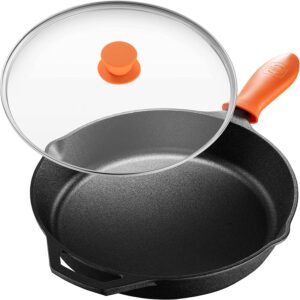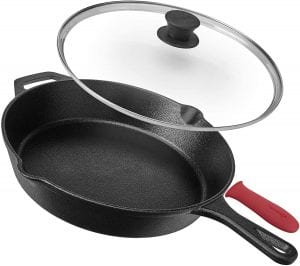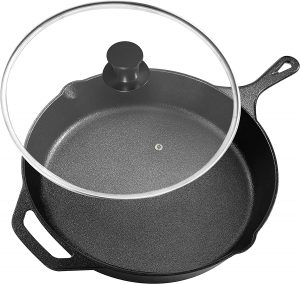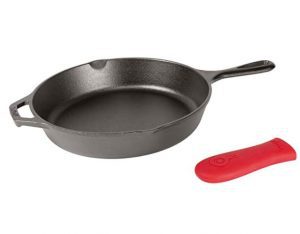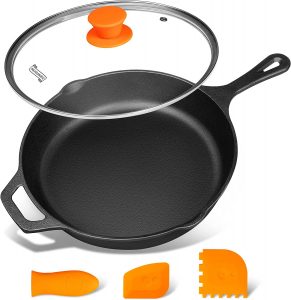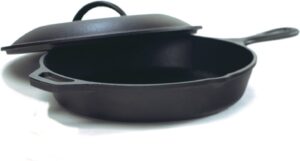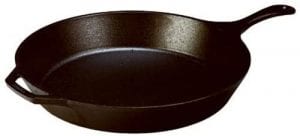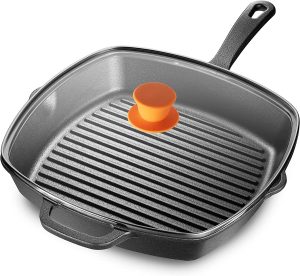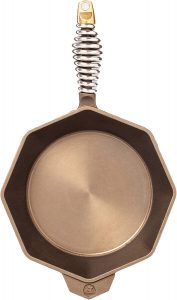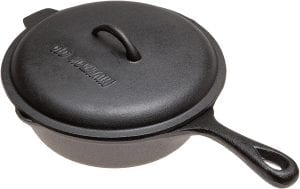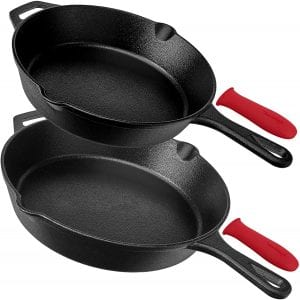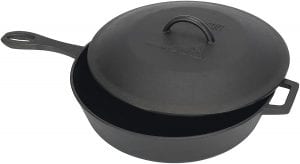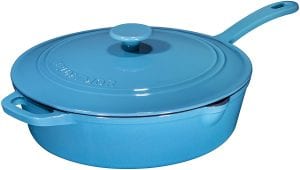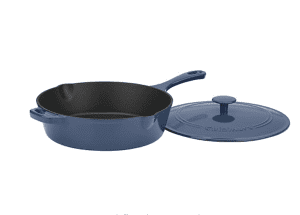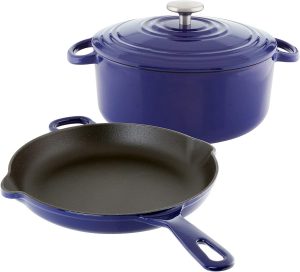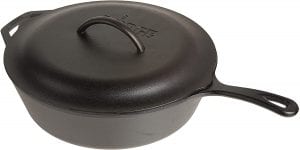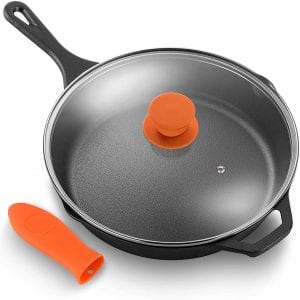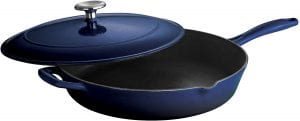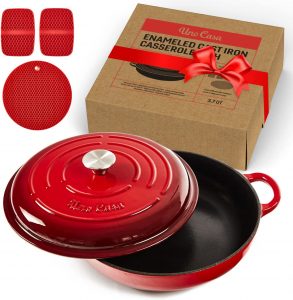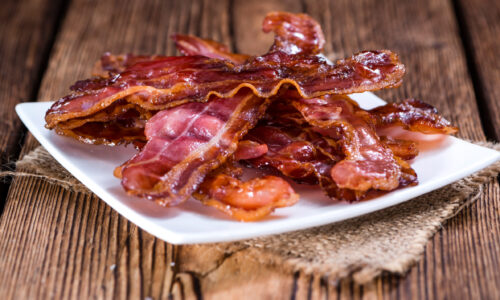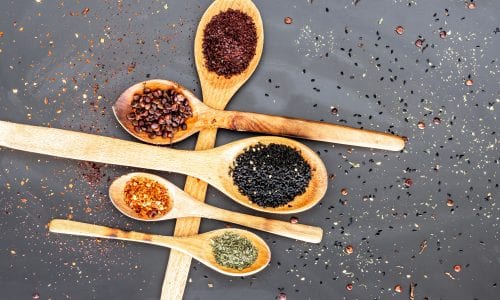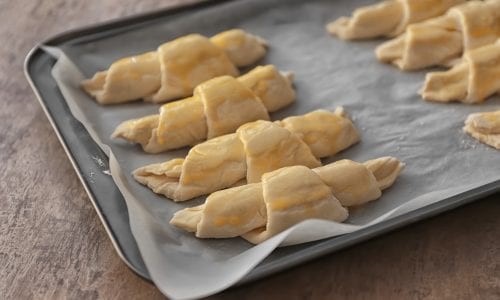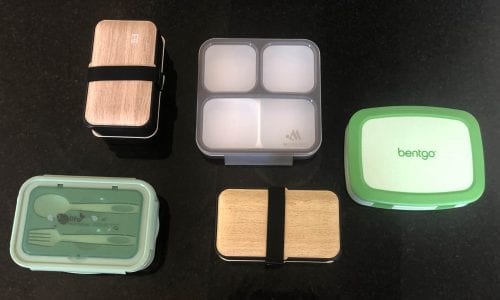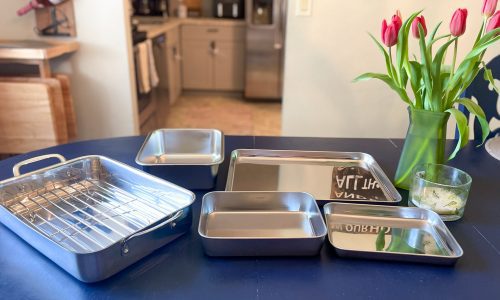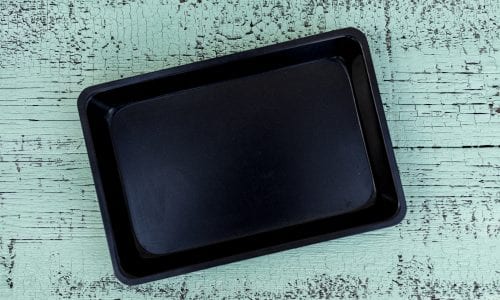The Best Cast Iron Skillets

Our Review Process
Don't Waste Your Money is focused on helping you make the best purchasing decision. Our team of experts spends hundreds of hours analyzing, testing, and researching products so you don't have to. Learn more.
Our Picks For The Top Cast Iron Skillets
- 1. Legend Pre-Seasoned Cast Iron Skillet With Lid, 12-Inch
- 2. Cusinel Precision Heat Cast Iron Skillet With Lid, 12-Inch
- 3. Utopia Kitchen Even Heat Cast Iron Skillet With Lid, 12-Inch
- 4. Lodge Pre-Seasoned Cast Iron Skillet, 10.25-Inch
- 5. MICHELANGELO 3-Ply Easy Clean Cast Iron Skillet With Lid, 10-Inch
- 6. Lodge Easy Clean Stovetop Cast Iron Skillet With Lid, 12-Inch
- 7. Lodge Pre-Seasoned Large Classic Cast Iron Skillet, 13-Inch
- 8. Legend Long-Handled Cast Iron Skillet With Lid, 12-Inch
- 9. FINEX Nonstick Heirloom Cast Iron Skillet With Lid, 12-Inch
- 10. Old Mountain 10109 Pre Seasoned Cast Iron Skillet With Lid, 10.5-Inch
- 11. Cuisinel Precision Heat Searing Skillet Set, 2-Piece
- 12. Bayou Classic 7445 Easy Clean Cast Iron Skillet With Lid, 5-Quart
- 13. Bruntmor Long Lasting Cast Iron Skillet With Lids, 12-Inch
- 14. CUISINART Porcelain Cast Iron Skillet With Lid, 12-Inch
- 15. Chantal All Cooktops Cast-Iron Skillet & Dutch Oven Set With Lid
- 16. Lodge L10CF3 Deep Cast Iron Skillet With Lid, 5-Quart
- 17. NutriChef PFOA-Free Cast Iron Skillet With Lid, 10-Inch
- 18. Tramontina 80131/068DS Oven Safe Cast Iron Skillet With Lid, 12-Inch
- 19. Uno Casa Widened Handles Cast Iron Skillet With Lid, 3.7-Quart
Designed with the home chef in mind, this cast iron skillet with lid offers many attractive features. The pan has two pour spouts, as well as an extended handle that's easy to grip. An integrated helper handle and a glass lid with heat resistant handle are also included.
Tempered Glass Lid IncludedThis cast iron cookware comes pre-seasoned and ready to use.
You can make many different meats, vegetables and desserts with this useful cast iron skillet with lid. It is highly durable and is pre-seasoned. The heat-resistant handle comes with a silicone holder to keep your hands safe while cooking.
Lots of OptionsThis cast iron skillet with lid is perfect for frying, grilling, baking, braising, sautéing and much more.
Use this cast iron skillet with lid indoors to fry up some chicken, or outdoors over a fire to make hot dogs while on vacation. The pan measures 12 inches in diameter and comes pre-seasoned and ready for use. It's naturally non-stick and perfect for cooking everything from scrambled eggs to grilled salmon.
Most VersatileEven heat distribution is what you'll get from this top-notch cast iron skillet with lid.
If you're searching for a pan that cooks ingredients evenly, this skillet is the answer. It also holds heat much better than other pans. Home chefs will appreciate the assist handle that makes transferring the pan from the stove to the table a breeze.
Comes Pre-SeasonedWith this skillet, you'll receive a complimentary red silicone handle holder.
Buying Guide
For most home cooks and professional chefs, having a cast-iron skillet in the kitchen is a must. It’s a highly versatile kitchen tool that can make anything from appetizers to mains to desserts. Having a cast iron skillet with a lid increases its versatility because you can now also braise meats and cook stews and soups in it.
Cast iron is a heavy-duty cookware material that provides excellent heat retention. It can be used at high temperatures so it provides cooks with a wide range of foods they are able to cook. Cast iron is also highly durable so you can expect to have the same skillet for several years. Cast iron skillets exist in many cultures and have different names, such as woks and karahi.
In order to use cast iron, it’s important to season the pan. This helps it to develop a non-stick coating so that you don’t need to add too much fat when cooking. The two main types of cast iron skillets are bare and enameled. Bare cast iron skillets are usually created from a single piece of metal which includes the handle. They are not seasoned, hence the term bare. These types of skillets are ideal for high temperatures, such as using them on the stovetop and then transferring them to the oven to finish the dish.
Enameled cast iron pans, on the other hand, have a vitreous enamel glaze on the surface of the pan. As a result, these pans do not need to be seasoned before use. This glaze also helps to prevent rust and enables the pan to be thoroughly cleaned. These skillets are ideal for slow cooking.
What to Look For
- One of the most important things to look for when buying a cast iron skillet is whether the pan has been seasoned or not. If it’s a bare cast iron skillet, it will have a rougher texture and will not come seasoned. This means that in order to use it and ensure your food doesn’t stick to the pan, you will have to season it yourself. A cast-iron skillet that has an enameled finish will not need to be seasoned and can be used right away. You will also use less fat when cooking with this kind of pan because the enamel coating will ensure the food doesn’t stick. Keep in mind that bare cast iron pans can handle higher heat than coated ones.
- Consider how the cast iron skillet can be used. Some are only designed to be used on an electric or gas stove, while others can go in the oven as well. Some can also be used on an outdoor grill or campfire, so they are ideal if you love to camp. Think about how you’ll be using your cast iron skillet most often and purchase the one that meets your needs.
- Review the shape and size of the pan itself. For example, a pan with higher sides can be used to make soups and stews in addition to everything else, so it provides an extra layer of versatility.
- While the pan itself is important, the handle is what provides cooks control and comfort. You need a skillet that has a strong, ergonomic handle so you can carefully maneuver your pan. Keep in mind that the handles of the cast iron skillet often heat up just as much as the pan itself, so in order to hold them, you will need some kind of heat-proof covering. Some cast-iron skillets are sold with a silicone cover for the handle, which makes it easier to control your skillet.
More to Explore
5 mistakes you’re making with your cast-iron skillet—and how to fix them
1. It comes pre-seasoned, so you don’t season it anymore
First, let’s make sure we arrive at the same definition of “seasoning.” We’re not talking about adding a dash of salt and pepper, or your proprietary blend of taco seasoning. In the realm of cast-iron cooking, seasoning means fat or oil that is baked into the skillet. The modern-day cast-iron skillets come pre-seasoned (defined: they’ve got a nice layer of polymerized oil in the pan). Still, it’s a good idea to add some extra protection. Serious Eats suggests doing this by heating it on the stove top until it’s smoking hot, rubbing a little oil into it and then letting it cool. Repeat the process a few times.
2. You run it through the dishwasher
Do this, and you’ve committed the cardinal sin of cast-iron skillet ownership! Running it through the dishwasher will remove that perfect seasoning. Also, you want to avoid harsh soaps and scouring pads when it comes to your skillet, all of which can chip away at the seasoning, according to Epicurious. Instead, use a mild soapy water on the first wash.
3. You let your cast-iron skillet soak
To make it easy on yourself, wash your pan when it’s still warm. Epicurious relays these instructions: Use hot water, a sponge or a stiff, non-metal brush to remove the cooking residue. If you’ve got food that’s stuck to the bottom (hey, it’s inevitable!), call in some back-up in the form of coarse kosher salt to help slough off the stubborn bits. Use tongs to squeeze a folded kitchen towel and then scrub the pan with the help of the salt.
4. You don’t let it dry long enough
After washing your cast-iron, make sure it’s dry. As in “bone dry,” suggests Food & Wine. Too much moisture can cause rust, which becomes tricky to remove. If your trusty cast-iron skillet gets a little rusty, the best fix is to scrub the rusted areas with steel wool or a soapy scrub pad and then thoroughly dry the pan, according to the experts at Food & Wine.
5. You don’t introduce acidic foods to your skillet
You may have heard that you shouldn’t cook acidic foods in your cast-iron skillet. But this falls in the “myth” category. Cast-iron cookware is game for just about anything. While you might not want to let tomato sauce simmer for hours, Rodale’s Organic Life warns, there’s no harm in cooking with acidic foods.

